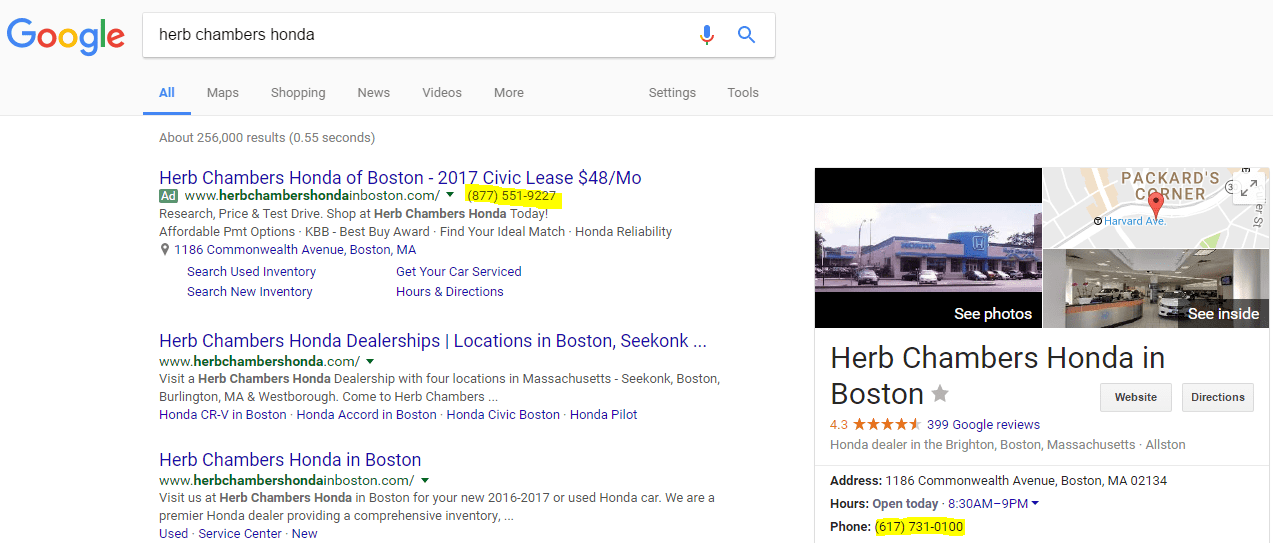
Google Is Changing How Call Extensions Show in 2 Weeks – Here’s What You Need to Know
For years, local advertisers have relied on a well-structured Google My Business account to manage how their businesses appear on the SERP, both for their organic listings and their paid ads. A complete Google My Business Listing could help you dominate the local organic SERP, highlighting information about your business, address, phone number, hours, reviews, pictures, and (quite literally) put your business on the map. Linking your Google My Business to your AdWords account allowed you to show ads on Google Maps and create location extensions to show your address to local searchers right in your ads.
This is changing. Google announced yesterday that starting on January 19, AdWords will also begin to show local searchers the local phone number of that advertiser’s address as it’s listed in their Google My Business account, regardless of how they’ve set up their call extensions. That means that if you’re using call tracking or another number phone in your call extensions, that call extension number will no longer appear alongside your ads on the local SERP with your location extension.
Google’s full announcement is available below:
Who Is Most Affected by this Change?
This change only affects how ads appear when a location extension is being shown and local extensions only appear when a user is relatively close to that location. Call extensions will still appear unchanged when location extensions do not show, which is the overwhelming majority of the time. Most regional, national and international advertisers won’t notice any significant changes.
However, local advertisers who show their location extensions more frequently may notice more calls going to their Google My Business number rather than their Call Extension number. To see how often your location extensions show, view the location extension metrics under the “Ad Extensions” tab:
The Pros
From a user perspective, this change unifies the SERP and ensures that the information Google is sharing is consistent between the paid ads and the organic local results. Users have every reason to be confused whenever Google shows different phone numbers for the same local business address:
In the screenshot above, Google shows different numbers for the same business address in the paid ad (top result) and the organic listing (right). Google’s change on Jan. 19 will effectively end that discrepancy so that users will only be served one phone number for local businesses.
From an advertiser perspective, this may make account management easier for a lot of local businesses. No longer will they need to create several different call extensions and different campaigns just to make sure they’re directing calls to the correct location. Once you’ve set all of this up within your Google My Business account, you’ll always serve the right phone number with the right location. Additionally, since location extensions are created at the account level, rather than the campaign level like call extensions, advertisers won’t need to worry about forgetting to apply a call extension to an individual campaign.
The Cons
While ads will still drive the same number of calls, the major drawback to this change is that local advertisers will lose the ability to track and report these calls from ads as conversions, which is of course the whole point of call tracking. This will make managing and optimizing your account particularly difficult if your main goal is to drive calls.
Luckily, if this change absolutely terrifies you, Google will allow you to opt out of showing location-specific phone numbers in your ads by filling out this form before January 19, 2017.
What You Can Do to Prepare for the Change:
- Don’t panic! Determine how much this change will affect you by reviewing how often your location extensions appear. It may surprise you how infrequently your extensions show, especially if you’re targeting a large area.
- Make sure your Google My Business listings and phone numbers are correct and up to date for all your locations.
- If your main goal is to get more phone calls, consider using call-only campaigns. You’ll still be able to track mobile click to call actions from mobile devices.
- If you’re worried about missing out on calls from your call extensions, make sure you start tracking calls from your landing pages as well! Most prospects will want to visit your site before making a call and often landing pages can drive 4-5 times as many calls as the call extensions on the SERP. Make sure you’re using a complete call tracking solution that can track calls from your landing pages as well.
- If all else fails, you do have the option to unlink your Google My Business account from your AdWords account. You’ll no longer be able to serve location extensions or ads on Google Maps, but you’ll have complete control back of how your phone number appears alongside your ads!
Although change is often scary, Google integrating this kind of business data into local ads has the potential to be increasingly powerful in 2017 and make account management easier as well.











Comments
Please read our Comment Policy before commenting.